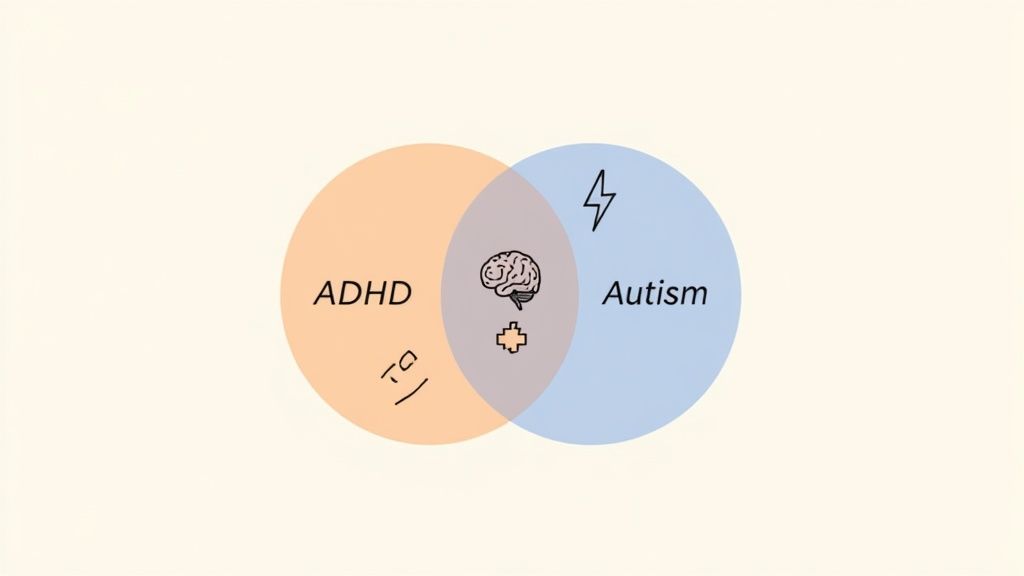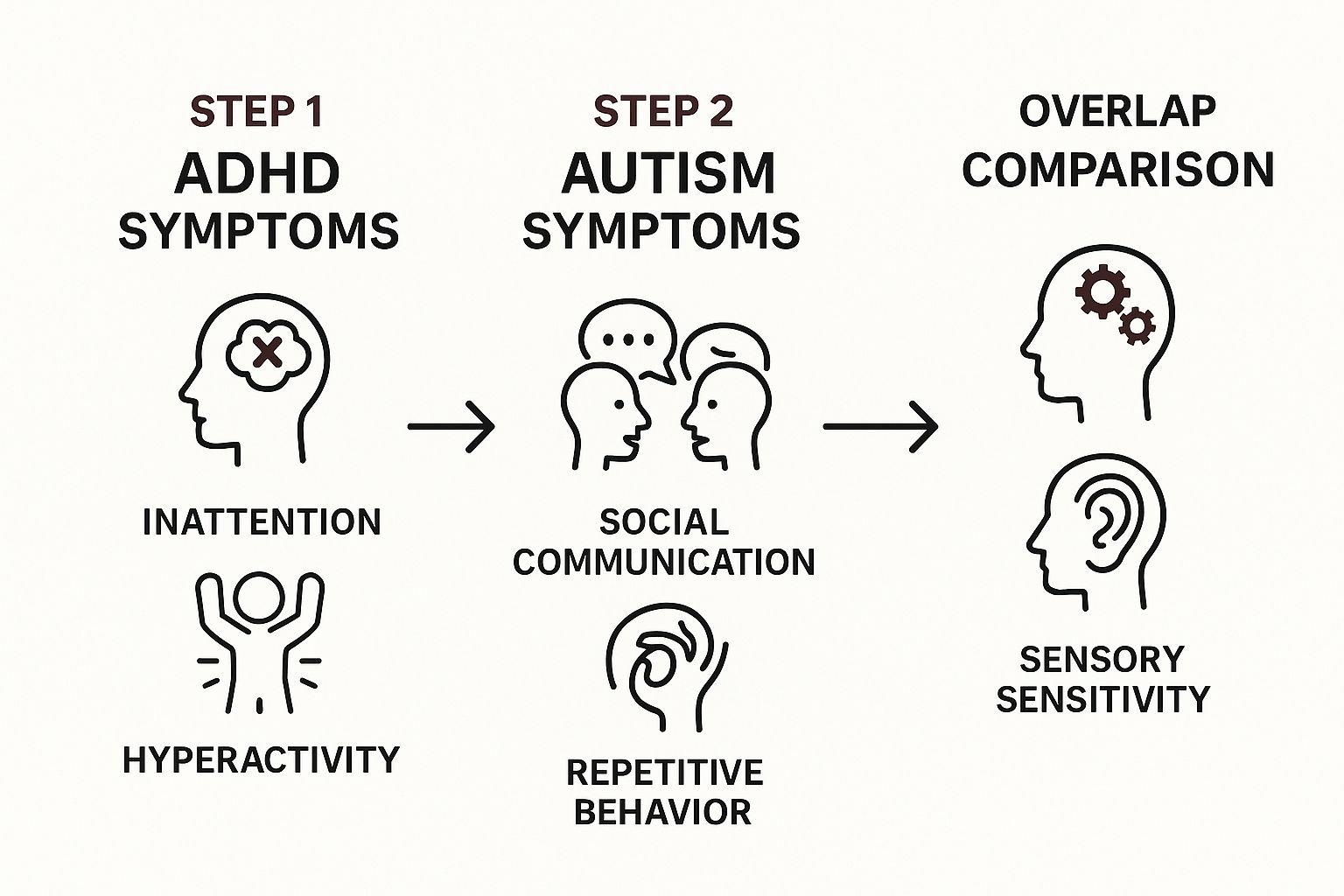Understanding The Hidden Connection Between ADHD And Autism
Many individuals and families navigate the complexities of ADHD and autism separately. They are often unaware of the significant interplay between these two neurodevelopmental conditions. It's common for these conditions to co-occur, sometimes referred to as AuDHD. This co-occurrence raises important questions about shared origins, overlapping symptoms, and accurate diagnosis for effective treatment.
Shared Origins and Overlapping Symptoms
Researchers are exploring potential shared genetic factors and overlapping brain development patterns between ADHD and autism. Both conditions can present challenges with executive function. This can impact abilities like organization, planning, and time management. Social difficulties and sensory sensitivities can also be present in both, although they may manifest differently. This overlap can make distinguishing between the conditions challenging and highlights the need for expert assessment.
Research indicates a strong correlation between the two diagnoses. Individuals with ASD (Autism Spectrum Disorder) are significantly more likely to have ADHD. Rates of ADHD are about 10 times higher in adults with autism compared to the general population. This suggests a shared underlying neurological basis, though the exact mechanisms are still being investigated. Learn more about this research here. This overlap adds complexity to diagnosis and underscores the importance of understanding the nuances of how these conditions interact. More information can be found here.
The Importance of Accurate Diagnosis
Understanding this connection is crucial because it changes how we approach diagnosis and treatment. Recognizing the possibility of both conditions co-occurring can lead to more accurate assessments and more effective interventions. Individuals then receive the specific support they need, addressing both ADHD and autism-related challenges.
The masking of symptoms, especially in girls and women, adds another layer of complexity. One condition can sometimes overshadow the other, making it difficult to identify both. This reinforces the need for comprehensive evaluations that consider the full spectrum of neurodevelopmental possibilities. Accurate diagnosis is essential for creating tailored treatment plans and providing appropriate support, leading to better outcomes and personalized strategies for individuals navigating the combined challenges of ADHD and autism.
Spotting The Signs: What To Watch For At Every Age
Early recognition of ADHD and autism can significantly impact a person's life. However, identifying these conditions isn't always easy, as symptoms can vary greatly across different age groups. This section will explore the developmental differences and behavioral patterns that may indicate ADHD, autism, or both conditions throughout life.
Early Childhood (Toddlers and Preschoolers)
In toddlers and preschoolers, early signs of ADHD might include excessive activity levels, difficulty focusing, and impulsivity. These children may seem constantly "on the go," struggling to sit still during activities like story time or meals. Early indicators of autism can include delayed language development, limited eye contact, repetitive behaviors, and unusual play patterns, such as lining up toys instead of engaging in imaginative play.
School-Aged Children
As children enter school, ADHD symptoms can become more noticeable in academic settings. Difficulties with organization, following instructions, and completing assignments are common. Children with autism may struggle with social interactions, understanding nonverbal cues, and adapting to changes in routine. They might also show intense interests in specific topics or engage in repetitive behaviors like hand-flapping or rocking.
Adolescence
During adolescence, ADHD can manifest as difficulty with time management, impulsivity in social situations, and challenges with planning for the future. Autistic teenagers may experience increased social anxiety, difficulty navigating complex social dynamics, and communication challenges. This is also when masking behaviors, particularly in girls and women, may become more pronounced. This happens as individuals try to fit in with their peers. This masking can make diagnosis more challenging since outward symptoms might be less obvious.
Adulthood
Many adults receive late diagnoses of ADHD and autism, often after years of struggling with unexplained challenges. In adulthood, ADHD can affect career performance, relationships, and daily functioning. Individuals may struggle with procrastination, disorganization, and difficulty maintaining focus. Autistic adults may experience challenges with social communication, sensory overload in busy environments, and difficulty adapting to changes. For ASD, boys are diagnosed 4.2 times more often than girls, showing a gender disparity in diagnosis rates. The average age of ASD diagnosis is around 4 years, with young adults experiencing the highest increase in diagnoses. Find more detailed statistics here.
The Importance of Professional Evaluation
Recognizing the potential signs of ADHD and autism is an important first step. However, it's essential to remember that these are just potential indicators. A formal diagnosis can only be made by a qualified professional. If you or someone you know exhibits these signs, seeking a professional evaluation for ADHD and autism is highly recommended. Early intervention and appropriate support can significantly improve a person's life, helping them develop coping mechanisms and strategies to thrive.
Your Assessment Journey: What Actually Happens
Understanding the steps involved in an assessment for ADHD and autism can significantly reduce anxiety and empower you to actively participate in the process. This section will guide you through what you can expect, from the initial screenings to the comprehensive evaluations.
Initial Screenings and Referrals
The journey often begins with recognizing potential signs, such as difficulty focusing, social challenges, or sensory sensitivities. This might lead you to consult with a primary care physician, therapist, or educator. These professionals can administer initial screenings or refer you to specialists for a formal assessment. Specialists might include psychologists, psychiatrists, or developmental pediatricians. You might also be interested in learning more about ADHD testing: How to master ADHD.
Comprehensive Psychological Assessments
A comprehensive psychological assessment forms the core of the diagnostic process. This involves a thorough review of your developmental history, current challenges, and behavioral patterns. To gather information about your strengths and weaknesses, clinicians often use standardized questionnaires, interviews, and direct observation.
Diagnostic Tools and Their Purpose
Clinicians use various tools to differentiate between ADHD and autism, and to identify when an individual has both conditions. The ADOS-2 (Autism Diagnostic Observation Schedule, Second Edition) is a commonly used assessment for autism. It involves structured activities that evaluate social interaction, communication, and play. For ADHD, clinicians frequently use rating scales that measure inattention and hyperactivity/impulsivity.
This infographic provides a visualization of the diagnostic process. It illustrates how clinicians assess for ADHD symptoms (inattention and hyperactivity), then autism symptoms (social communication and repetitive behaviors), and finally compare the overlap in areas like executive function and sensory sensitivity. The infographic highlights that while ADHD and autism present distinct symptom clusters, there is significant overlap, especially in areas like executive function and sensory sensitivities. This overlap emphasizes the importance of a thorough evaluation to understand the complex interplay between these two conditions.
To further clarify the distinct diagnostic criteria for ADHD and autism, as well as considerations for when both conditions are present, the following table provides a detailed comparison:
ADHD vs Autism Diagnostic Criteria Comparison
This table provides a side-by-side comparison of key diagnostic criteria, assessment tools, and evaluation processes for ADHD and autism spectrum disorder. It also highlights key considerations for dual diagnosis.
| Diagnostic Aspect | ADHD Criteria | Autism Criteria | Dual Diagnosis Considerations |
|---|---|---|---|
| Primary Symptoms | Inattention, Hyperactivity, Impulsivity | Persistent deficits in social communication and social interaction; Restricted, repetitive patterns of behavior, interests, or activities | Presence of both ADHD and autism symptoms, requiring careful assessment to differentiate and address the needs of each condition. |
| Onset | Symptoms present before age 12 | Symptoms present in early developmental period | Symptoms of both conditions may be present from early childhood, making accurate diagnosis more complex. |
| Impairment | Symptoms must cause clinically significant impairment in social, academic, or occupational functioning. | Symptoms cause clinically significant impairment in social, occupational, or other important areas of current functioning. | Impairment is often more significant when both conditions are present, impacting multiple areas of functioning. |
| Assessment Tools | Rating scales, behavioral observations, clinical interviews | ADOS-2, ADI-R, clinical observations, developmental history | Combination of assessment tools for both ADHD and autism is necessary for accurate diagnosis. |
| Diagnosis | Based on meeting specific criteria outlined in the DSM-5 | Based on meeting specific criteria outlined in the DSM-5 | Requires meeting full criteria for both ADHD and Autism Spectrum Disorder. |
This comparison table emphasizes the need for a comprehensive evaluation process to accurately differentiate and diagnose ADHD, autism, and cases where both conditions are present. The overlapping symptoms can make diagnosis challenging, requiring clinicians to carefully consider all aspects of an individual's developmental history and current functioning.
Evaluations for Adults vs. Children
While the core principles of assessment remain consistent, adult evaluations often differ from childhood assessments. When evaluating adults for ADHD and autism, clinicians consider adult life experiences, career challenges, and relationship dynamics. They may also gather information from family members or partners to develop a comprehensive understanding of the individual's lifelong experiences.
Preparing for Your Appointment and Insurance Considerations
Preparing for your appointment can greatly enhance the assessment's effectiveness. Gathering relevant documentation, such as school records or previous evaluations, provides valuable context. Understanding your insurance coverage for diagnostic assessments is also essential. Knowing what is covered and any potential out-of-pocket expenses can help you navigate the financial aspects of the process.
Receiving Your Diagnosis and Next Steps
After the assessment, the clinician will provide feedback, including a diagnosis, if applicable. This is a crucial time to ask questions and discuss next steps. These steps may involve therapy, medication, or other support services. Understanding your diagnosis is the first step toward developing a personalized plan to manage your condition effectively.
Navigating Dual Diagnosis: The Real Challenges And Wins
Receiving an ADHD and autism diagnosis can be a complex emotional experience. It often presents unique challenges not addressed by traditional single-condition approaches. However, by understanding how these two neurodevelopmental conditions interact, individuals can access more effective interventions and experience significantly improved outcomes.
The Interplay of ADHD and Autism
One of the central challenges of dual diagnosis lies in how ADHD and autism can influence each other. For instance, the impulsivity common in ADHD might conflict with the preference for routine often seen in autism. This can create internal conflict, making it difficult for individuals to fully understand their own behaviors and feelings.
Some autistic characteristics, such as difficulties with social interaction, can be intensified by the inattention and hyperactivity associated with ADHD. Conversely, some ADHD symptoms can be masked by autistic traits, adding layers of complexity to diagnosis. This makes accurate and comprehensive assessment for both ADHD and autism absolutely essential.
Treatment Approaches for Dual Diagnosis
Healthcare providers often face the difficult task of crafting treatment plans that address both ADHD and autism simultaneously, without worsening either condition. Generic, one-size-fits-all approaches are rarely effective, as the experience of dual diagnosis is highly individual.
Effective treatment plans must carefully consider the interplay between the two conditions. These plans often incorporate a combination of behavioral therapies, medication management, and personalized support strategies tailored to the individual's specific needs and challenges.
The Emotional Impact of Dual Diagnosis
Receiving multiple diagnoses can be an emotional rollercoaster. Individuals may experience a wide spectrum of feelings. Some might feel relief at finally having answers, while others might struggle with confusion and overwhelm.
Building a strong support system is crucial. The Sachs Center, for example, offers a variety of support services, including therapy, social skills groups, and online support "neurotribes." Connecting with others who understand the complexities of AuDHD can offer invaluable support and validation.
Finding the Right Path Forward
While a dual diagnosis presents unique challenges, it also opens doors to more focused interventions and ultimately, better outcomes. Understanding both conditions offers a clearer path forward.
By recognizing the specific strengths and challenges associated with a dual diagnosis, individuals can develop personalized strategies for success. This might include seeking accommodations in educational or workplace settings, or it might involve developing coping strategies for managing sensory sensitivities or social anxieties. The journey of dual diagnosis is ultimately one of self-discovery and empowerment.
Treatment That Works: Integrated Approaches For Both Conditions
Effectively treating individuals with both ADHD and autism, sometimes called AuDHD, requires a specialized approach. It's important to understand how these two conditions interact, sometimes making certain traits more noticeable while hiding others. Instead of treating each condition separately, an integrated approach is key for positive outcomes.
Addressing Overlapping Symptoms with Behavioral Therapies
Behavioral therapies are often the foundation of AuDHD treatment. These therapies help individuals develop coping mechanisms for challenges shared by both conditions.
For example, Cognitive Behavioral Therapy (CBT) can help manage emotional regulation, a common difficulty for people with both ADHD and autism. Therapies focused on social skills and executive function can also be highly beneficial. The Sachs Center's "Sachs Protocol," combined with evidence-based CBT and psychoeducation, is designed to address these unique needs. You can learn more on the Sachs Center website: ADHD & Autism Treatments.
Medication Considerations for Dual Diagnosis
Medication can be helpful in managing ADHD symptoms, even when autism is also present. However, careful consideration is vital. Some common ADHD medications might worsen certain autistic traits, such as anxiety or sensory sensitivities.
Finding the right medication and dosage takes close collaboration between the individual, their family, and healthcare providers. The goal is to balance addressing hyperactivity and inattention associated with ADHD while respecting the sensory and emotional needs of the autistic individual.
Coordinating Care Between Multiple Providers
Individuals with AuDHD often benefit from a team of healthcare professionals. This might include therapists, psychiatrists, educators, and occupational therapists. Effective treatment requires open communication and collaboration between these providers.
This ensures everyone works towards a shared goal, with interventions that complement each other, creating a unified, supportive environment. While complex, this integrated approach allows for addressing all aspects of the individual's needs.
Realistic Expectations and Progress Monitoring
Setting realistic expectations is crucial. Progress with AuDHD isn't always straightforward. There will be periods of growth and times where challenges seem more intense.
Regularly monitoring progress, considering the needs of both conditions, is key. This allows for adjusting the treatment plan as needed, ensuring it remains effective. It's about adapting strategies, celebrating successes, and building resilience.
Complementary Therapies and Educational Accommodations
Beyond traditional therapies and medication, options like mindfulness practices, art therapy, or occupational therapy can improve overall well-being. Educational accommodations tailored for both ADHD and autism can also greatly enhance academic performance and reduce stress. This might include flexible deadlines, sensory-friendly classrooms, or assistive technologies.
These added supports contribute to the individual's well-being and ability to succeed. For workplace support, explore accommodations designed for neurodivergent individuals: Accommodations for ADHD and Autism.
To provide comprehensive care, it's essential to treat the whole person. This involves open communication with healthcare providers, educators, and family, building a supportive network. The goal is to empower self-advocacy and allow individuals to actively participate in their treatment journey. This holistic approach recognizes how ADHD and autism are interconnected and aims to provide support in all aspects of life.
The following table provides a more detailed look at various treatment options:
Treatment Options for ADHD and Autism Dual Diagnosis: This table provides a comprehensive overview of treatment modalities, their effectiveness for single vs dual diagnosis, and implementation considerations.
| Treatment Type | ADHD Benefits | Autism Benefits | Dual Diagnosis Effectiveness | Implementation Notes |
|---|---|---|---|---|
| Behavioral Therapy (CBT, ABA) | Improves focus, reduces impulsivity, enhances emotional regulation | Improves social skills, reduces repetitive behaviors, addresses sensory sensitivities | Highly effective in addressing overlapping challenges | Requires consistent application and collaboration between therapists and family |
| Medication (Stimulants, Non-stimulants) | Improves attention, reduces hyperactivity | May help with irritability and impulsivity, but can exacerbate anxiety and sensory issues | Careful monitoring and dosage adjustments are crucial | Potential side effects need careful consideration |
| Occupational Therapy | Improves sensory processing, motor skills, and daily living skills | Addresses sensory sensitivities, improves motor coordination, and enhances adaptive behaviors | Supports overall functioning and independence | Tailored interventions are essential for individual needs |
| Speech Therapy | Not typically a primary treatment for ADHD alone | Improves communication skills, both verbal and nonverbal | Beneficial for individuals with AuDHD who have communication challenges | Focuses on pragmatic language and social communication |
| Social Skills Training | Can be helpful for individuals with ADHD who struggle socially | Core treatment for autism, improving social interaction and understanding | Addresses social challenges common to both conditions | Group and individual sessions can be beneficial |
This table highlights the importance of tailoring treatment to the specific needs of individuals with AuDHD. While some treatments are beneficial for both ADHD and autism, their implementation requires careful consideration of how they interact for each individual. A collaborative approach, involving various specialists and the individual themselves, is crucial for successful outcomes.
Why More People Are Getting Diagnosed Than Ever Before
The rise in ADHD and autism diagnoses isn't just a statistical blip. It signifies a growing recognition and understanding of neurodiversity. This means more people are finally getting the answers and support they need, often after years of struggling. This positive shift stems from several factors contributing to a more inclusive view of neurodevelopmental differences.
Improved Diagnostic Tools and Awareness
One key factor is the advancement of more precise diagnostic tools. These tools empower clinicians to distinguish between conditions and recognize when both ADHD and autism are present, often referred to as AuDHD. Increased awareness among healthcare professionals and the public has also led to more people recognizing potential signs and pursuing professional assessments. This increased awareness is vital for early intervention and timely support.
For instance, resources like the Sachs Center now provide comprehensive telehealth-based assessments for ADHD, autism, and AuDHD. These assessments utilize established self-report tools and clinical interviews. They provide detailed diagnostic reports, with an option for extended neuropsychological testing for academic accommodations and learning disorder identification.
According to the Centers for Disease Control and Prevention, approximately 1 in 31 children aged 8 years have been identified with ASD, a significant increase in diagnosis rates. Globally, studies show the number of children and adults diagnosed with ASD has grown by 175% over a decade. This data underscores the increasing prevalence of ASD and the need for ongoing research and support.
Reduced Stigma and Increased Acceptance
Another important factor is the lessening stigma surrounding neurodevelopmental differences. As society becomes more accepting of neurodiversity, individuals feel more comfortable seeking help and sharing their experiences. This growing acceptance fosters a more inclusive atmosphere where neurodivergent individuals can flourish. It also cultivates a deeper understanding of the unique challenges and strengths linked to conditions like ADHD and autism.
The Impact of Increased Diagnosis
The rise in diagnoses has a ripple effect, reshaping educational resources, workplace accommodations, and societal perceptions. Schools are adopting more inclusive practices and personalized learning strategies. Workplaces are providing accommodations to support neurodivergent employees. These changes benefit not only diagnosed individuals, but also families, schools, and communities.
Addressing Concerns About Overdiagnosis
While increased awareness is generally positive, there are valid concerns about overdiagnosis. Some worry that typical childhood behaviors are being misconstrued as pathological. However, it’s critical to differentiate between normal developmental variations and clinically significant impairments affecting daily life. Accurate evaluations by qualified professionals are essential to distinguish between these and ensure interventions are provided only when necessary. The focus should remain on providing support and resources to those who truly need them, while avoiding unnecessary labels. This necessitates a balanced approach, recognizing both the potential advantages and risks of increased diagnoses.
Building Your Support Network For Long-Term Success
Success with an ADHD and autism dual diagnosis goes beyond initial treatment. It involves building a strong, adaptable support network to help navigate the complexities of both conditions. This network should grow and change with your needs, offering consistent encouragement and practical help. This section explores building that network and developing strategies for long-term success.
Family and Friends as a Foundation
Family and friends are the core of your support system. Educating them about ADHD and autism, particularly how the two conditions interact, can create a more understanding and empathetic environment. Sharing resources like books, websites, or articles, along with open communication about your experiences, can deepen their understanding.
This shared knowledge strengthens your bond and reduces potential misunderstandings that might arise from the challenges of dual diagnosis. Having informed and supportive loved ones can make a significant difference in your overall well-being.
Healthcare Professionals: A Multidisciplinary Approach
A team of healthcare professionals provides specialized guidance. This team might include therapists, psychiatrists, and other specialists who address specific needs related to both ADHD and autism. For example, a therapist might help develop coping mechanisms for social anxiety, while a psychiatrist can determine appropriate medication if necessary.
Open communication between these professionals is vital. A coordinated approach ensures comprehensive care and addresses all aspects of your dual diagnosis. This collaborative approach allows professionals to share insights and develop a cohesive treatment plan.
Community Resources and Support Groups: Finding Your Tribe
Connecting with community resources and support groups offers invaluable peer support. Organizations dedicated to ADHD and autism often offer workshops, support groups, and educational materials. Connecting with others who understand dual diagnosis can foster a sense of belonging and reduce feelings of isolation.
These connections also provide opportunities to share strategies and learn from the lived experiences of others. Discovering you are not alone in your journey can be incredibly empowering and validating. Learn more in our article about Accommodations for ADHD and Autism.
Developing Self-Advocacy Skills: Speaking Your Needs
Developing self-advocacy skills is crucial. This involves clearly communicating your needs to healthcare providers, educators, and employers. It also means setting boundaries and asking for accommodations when necessary.
For example, in the workplace, you might request a quieter workspace or flexible work hours to manage sensory overload or concentration challenges. Self-advocacy empowers you to take control of your well-being and ensures your needs are met effectively.
Managing Life Transitions: Planning for Change
Life transitions, like changing schools or starting a new job, can be especially challenging for individuals with ADHD and autism. Careful planning and proactive preparation are essential. Breaking down large transitions into smaller, manageable steps can reduce anxiety and overwhelm.
Developing coping strategies for unexpected situations is also helpful. This might include practicing mindfulness techniques or having a designated quiet space to retreat to when feeling overwhelmed.
Educational and Career Considerations: Finding the Right Fit
Educational and career choices should align with your strengths and interests. Consider the specific challenges and advantages of your dual diagnosis. For some, a structured academic setting might be beneficial, while others might thrive in more flexible learning environments.
Similarly, certain careers might be more suitable than others. Choosing a career path that embraces your neurodiversity can enhance job satisfaction and long-term success.
Maintaining Mental Health: Prioritizing Well-being
Maintaining mental health is an ongoing process. Managing stress, getting enough sleep, and engaging in enjoyable activities are important self-care practices. Additionally, seeking professional support when needed is crucial for navigating the emotional challenges that can accompany dual diagnosis.
This includes seeking therapy for anxiety, depression, or other mental health concerns. Prioritizing mental well-being builds resilience and helps you navigate the complexities of dual diagnosis with greater strength and confidence.
Connecting with others who understand the unique journey of dual diagnosis is invaluable. It creates a sense of community and provides ongoing encouragement. This network can be a lifeline, offering support during challenging times and celebrating successes along the way.
The Sachs Center provides comprehensive support for individuals with ADHD, autism, and dual diagnoses. Visit the Sachs Center to learn more about diagnostic testing, therapy, and support groups that can help you build a strong foundation for long-term success.



